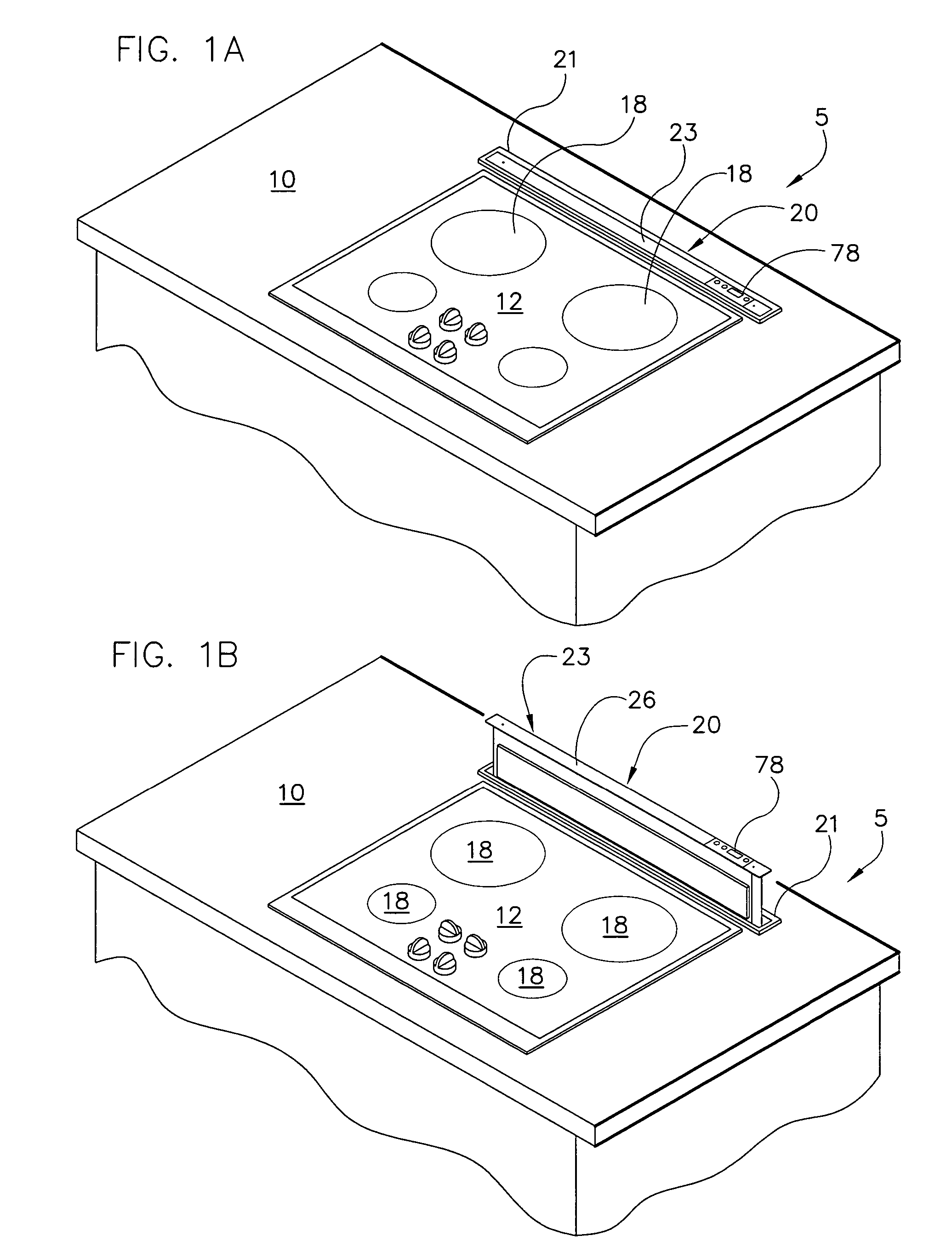With the need for more draw / vacuum / suction comes a large motor, which increases costs,
noise, size, and weight.
However, the inherently light construction of the forward curved blade does not permit this wheel to be operated at speeds needed to generate high static pressures and is generally not used in telescoping downdraft ventilators for that reason.
A draw back to this type is that it needs to be designed for twice the speed (for ruggedness) that increases the cost of the unit.
Axial flow fans are generally not used for telescoping downdraft ventilator as they do not provide the static pressures needed for the drawing / vacuum / suction, size, and spacing requirements.
Without the aperture, the fan is not truly a
propeller fan, since it cannot positively move air from one space to another.
This bending of the
airflow reduces the air draw / vacuum / suction effectiveness of a telescoping downdraft ventilator using a
centrifugal fan / blower and results in poor venting performance.
Also a big issue with centrifugal fans / blowers is the
noise.
These units are very loud and users find this to be a problem when using present telescoping downdraft ventilators.
Another issue is that current telescoping downdraft ventilators of present designs stop only at full up (open) and full down (closed) and use mechanical or tactile type controls to control and operate the removal of air and the stop points of the up and down movement.
These mechanical / tactile type controls are inaccurate and often do not work properly.
These types of products provide inaccuracies and other operating problems in an often dirty, hot, and sticky
working environment.
Further, they have problems maintaining a
set point partly due to the design of the telescoping downdraft ventilator and method of drawing air, but also do to the inaccuracy of the mechanical switches themselves.
Moreover, because they operate in an environment consisting of heated air, steam, oils, greases,
particulates and effluents, without proper protection these switches fail by working
too slowly,
cracking, discoloring, becoming harder to turn, failing to operate, chattering, and failing in
repeatability.
Moreover, if mechanical switches and / or controls are used on cook tops in outdoor environments like rain,
snow, sun, and UV, special sealings are required to prevent intrusion of these environmental conditions and
premature failure or
reduced product life.
The need for special sealed controls used in these environments increases the price of a telescoping downdraft ventilator that is used outdoors.
In the manufacturing process of these tactile switches,
contamination can enter the space, which over time causes problems for the user and sometimes results in failure.
Thus, adding an extension to any switch can cause problems for the user both in a build up of
contamination but also in the ability to clean.
Further, no proper
airflow detection method has been provided to indicate to the user it is time to change the filter.
Other manufactures have a
run time setting to indicate when the filter should be removed, however, this does not detect
if filter is truly plugged.
For the heavy user, the filter needs cleaning sooner and this feature is a problem.
For the light user, while a
metal mesh filter can be washed and replaced, frequent replacement of a disposal filter can get costly.
Some present designs are also limited to islands only, primarily due to their bulky size.
With the present units built into an island, the ability to provide light is a problem for the user.
While overhead range hood-type units provide lighting from above, such telescoping downdraft ventilators do not provide lighting.
Thus, the user has problems using this product.
Other issues are presented with present telescoping downdraft ventilators
stemming from the height that the unit extends up from the counter top.
The low extending units provide no effective draw when a large tall pot is place on a burner.
On the other hand, the units that extend 15 inches provide limited effectiveness when the user uses a low fry pan.
These now cause problems because the drawing air can extinguish the gas
flame.
No present units provide varying heights, which would reduce these problems.
Issues also remain with the present telescoping downdraft ventilator moving smoothly up and down.
Mechanical switches used to detect stopping points for both up and down are plagued with reliability problems.
Screw drives have been used on high end telescoping downdraft ventilators, but again have problems with mechanical switches and levers.
For example, the switches and levers cannot detect obstructions during travel up and down.
Further, these problems and failures increase the cost of manufacture and maintenance.
Present designs are also often large and bulky.
However, for a telescoping downdraft ventilator built into a cabinet or in an island, the space below the unit is limited especially for a user to use.
This is due to the size of the centrifugal blower, and the size of the base housings presently used.
 Login to View More
Login to View More  Login to View More
Login to View More 


